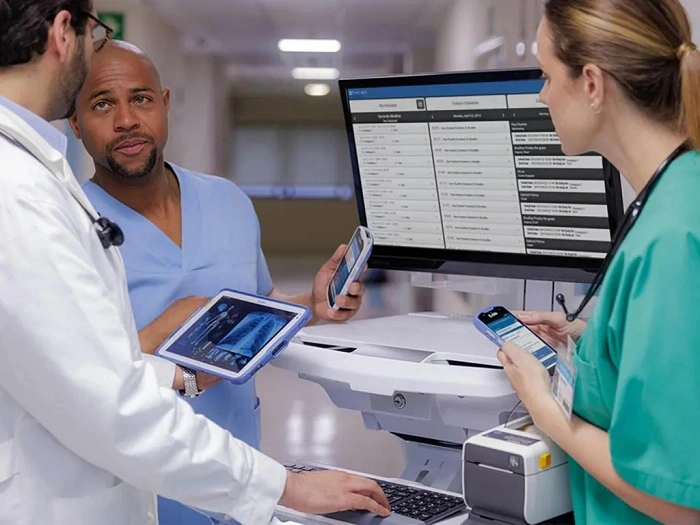What is the hospital information system?
A Hospital Information System (HIS) is a comprehensive, integrated healthcare software platform that centralizes clinical, administrative, and financial data across a hospital. Unlike standalone tools such as Electronic Medical Records (EMR), Electronic Health Records (EHR) or billing software, HIS connects every department into a unified ecosystem that covering patient management, clinical documentation, scheduling, inventory, billing, and regulatory compliance.
Today, leading hospitals and healthcare providers adopt HIS not only to store patient data but also to automate workflows, ensure interoperability between departments, enhance patient safety, and support digital health transformation. In short, HIS acts as the backbone of modern hospital IT infrastructure.
Before exploring the core features and benefits of a hospital information system, it’s important to understand how these systems have evolved over time, shaping the way hospitals manage data, coordinate care, and deliver better patient outcomes.
History of hospital information systems
The development of Hospital Information Systems (HIS) mirrors the digital transformation of healthcare over the past six decades – from isolated administrative tools to integrated, intelligent ecosystems that support every aspect of hospital operations.
1960s–1970s: The beginning of digitalization
Early HIS were introduced to manage administrative tasks such as billing, payroll, and inventory. These mainframe-based systems were costly, limited in scope, and primarily used by large hospitals to streamline financial processes.
1980s: Expanding into clinical functions
With the rise of personal and departmental computing, hospitals began implementing digital systems in clinical areas like laboratories, radiology, and pharmacies. This marked the first step toward integrated, hospital-wide data management.
1990s: Integration and connectivity
Healthcare providers began connecting departmental systems through local networks, enabling data sharing across hospital units. The introduction of electronic medical records (EMR) laid the groundwork for today’s electronic health records (EHR), making patient data more accessible and consistent.
2000s: Digital transformation era
Wider adoption of HIS was driven by global healthcare reforms and compliance standards. Systems evolved into web-based platforms supporting interoperability, clinical decision support, and large-scale data exchange between facilities.
2010s – present: Smart and connected healthcare
Modern HIS are cloud-based, mobile-enabled, and powered by artificial intelligence, IoT, and analytics. These systems not only automate workflows but also enhance clinical decision-making, improve patient experiences, and enable value-based care through real-time data insights.
From mainframe computers to intelligent digital platforms, Hospital Information Systems have become the backbone of modern healthcare infrastructure, enabling hospitals to operate more efficiently, deliver higher-quality care, and make data-driven decisions.
Classification of hospital information systems
Hospital Information Systems (HIS) can be classified in several ways, based on their function, architecture, or scope of use. Understanding these classifications helps healthcare organizations choose the right system for their operational and clinical needs.
Based on functionality
- Clinical information systems (CIS):
These systems focus on managing clinical data related to patient care, including electronic health records (EHR), laboratory information systems (LIS), radiology systems (RIS), and pharmacy management. They help clinicians make informed decisions, improve accuracy, and ensure patient safety. - Administrative information systems (AIS):
These handle non-clinical hospital functions such as billing, human resources, scheduling, and financial management. AIS ensures smooth operations, cost control, and compliance with hospital administration standards. - Strategic information systems (SIS):
Used by hospital executives and decision-makers, these systems provide analytics, dashboards, and performance indicators. They support long-term planning, policy development, and resource allocation across departments.
Based on system architecture
- Centralized HIS:
All data is stored and processed in a central server. This model ensures high consistency and easier management but may be less flexible for large hospital networks. - Distributed HIS:
Data and applications are spread across multiple servers or locations. This allows better scalability and autonomy for different departments or branches while maintaining interoperability through integration standards. - Web-based or cloud-based HIS:
Modern systems increasingly use web or cloud architecture to support remote access, scalability, and data security. Cloud-based HIS solutions are ideal for organizations seeking flexibility and reduced infrastructure costs.
Based on scope of implementation
- Departmental HIS:
Developed for specific hospital units (e.g., laboratory, pharmacy, radiology). These systems are often the first step before full HIS integration. - Hospital-wide HIS:
Integrates multiple departments into a single platform to enable real-time data sharing and cross-departmental coordination. - Enterprise or regional HIS:
Used across a network of hospitals, clinics, or regional healthcare systems to standardize data and support interoperability between different facilities.
In summary: The classification of Hospital Information Systems depends on how hospitals intend to use them – whether for clinical decision-making, administrative control, or enterprise-wide coordination. Choosing the right combination ensures better efficiency, compliance, and patient care outcomes.
Benefits of hospital information system
The importance of a Hospital Information System (HIS) is undeniable in modern healthcare. Below are three core benefits that highlight why hospitals worldwide are adopting it:
- Improve patient care: HIS gives healthcare workers quick access and up-to-date data on each patient’s state through digital medical records. From there, they can offer more accurate diagnosis care and minimize prescribing pitfalls.
- Enhance operational performance: A hospital information system can turn your healthcare facility into a paperless workplace. Your staff can focus on treating patients instead of spending endless hours on paperwork and manual processes. Additionally, automating billing and insurance claims can boost accuracy and remove stress among staff.
- Comply with government regulations: HIS provides a centralized and standardized way of storing hospital data, ensuring compliance with government regulations and international healthcare standards. It also strengthens cybersecurity, protecting sensitive patient information from breaches or misuse.
- Cost savings and resource optimization: HIS helps hospitals cut down expenses on printing, storage, and redundant administrative staff. Automated processes mean fewer errors that could lead to financial losses. Resources are allocated more effectively, ensuring that human and financial capital are used where they matter most: patient treatment.

Modules of hospital information system
Not every HIS is the same. They usually consist of several modules with specific functions. The more components it has, the larger the system. The key is to determine which module best suits your needs and operation.
Let’s walk through some standard modules of every hospital information system:
1. Core system
Being a Hospital Information Management (HIM), its underlying core is how the data is being managed and streamlined. The core system works with this by providing a central place to standardize and manage every input data.
Sometimes, it can be upgraded into a sub-system such as Electronic health/ medical record (EHR/EMR). From there, the core system can also support daily administrative tasks such as appointment scheduling, distributing patients, and more.
2. Business/Financial system
This module works with financial issues, insurance claims, healthcare billing, and accounting. Automating these processes reduces errors, accelerates reimbursements, and provides hospital administrators with better financial oversight.
3. Departmental management system
As its name implies, this module contains sub-software that explicitly serves a department. Yet all of them are connected to streamline data and keep information up to date.
For example, laboratory information system (LIS) for coordinating test results and lab research; radiology information system (RIS) or picture archiving and communication system (PACS) for storing and transmitting medical image; and patient tracking system for remote healthcare.
This integration ensures that every department, from labs to radiology, works with accurate, real-time data.

4. Inventory and procurement system (PIMS)
This module tracks the supply chain and usage of medicine, chemicals, and medical equipment. Some systems extend this to pharmacy management, helping hospitals avoid shortages, prevent overstocking, and optimize procurement.
5. Human resources management system (HRM)
A hospital’s workforce is one of its biggest assets. HRM modules handle staff records, performance tracking, training, scheduling, and payroll. While some hospitals integrate this within HIS, others may use separate HR software.
Must-have features of hospital information system
Your hospital information system doesn’t necessarily contain all the above modules. However, to make it truly functionable and useful, you must have these basic features:
Patient management
HIS provides a comprehensive patient management system, including patient information, medical history, diagnosis, medication records, and treatment plans. This helps doctors follow patients’ journeys and provide seamless and effective care.
Appointment scheduling
This feature helps patients schedule appointments simply and quickly in advance. It reduces wait time for patients, as they will be immediately checked once they show up. It gives patients a good start for the next health care steps.

For healthcare facilities, it cuts the check-in line, prevents chaos at the reception, removes stress, and helps administrative staff assign doctors and examination hours more accurately.
Claims billing and financial management
This feature allows healthcare facilities to closely monitor and manage their financial condition. The software integrates automatic payment features and insurance integration, enabling quick and accurate payment transactions and claims. This minimizes human error and accelerates reimbursement cycles.
Pharmacy and inventory management
Hospital information system tracks and manages patients’ medications and usage to prevent medication shortages. In addition, the system monitors and manages medical supplies warehouses and inventory.
Electronic prescriptions and alerts
Doctors can issue e-prescriptions instantly, reducing handwriting errors. Integrated alerts notify staff of drug interactions, allergies, or dosage issues to improving patient safety and treatment accuracy.
Communication and Reporting
Real-time messaging, reporting tools, and dashboards enhance collaboration among doctors, nurses, and administrative staff. HIS can also generate compliance and performance reports to support decision-making.
Use case of hospital information system
Hospital Information Systems are highly adaptable and can be applied in different types of healthcare facilities, depending on their size, specialty, and operational needs. Below are some common use cases that demonstrate how HIS adds value across contexts:
Public hospitals
Large government-funded hospitals deal with thousands of patients daily. HIS helps them manage high patient volumes, optimize bed occupancy, automate billing, and maintain compliance with strict regulatory standards. This ensures faster patient processing while reducing administrative burden.
Private hospitals and clinics
Private healthcare providers compete by delivering superior patient experience. HIS supports them with appointment scheduling, patient tracking, and billing integration, which reduce wait times and enhance personalized care. With analytics dashboards, private hospitals can also make smarter business decisions.
Specialty centers (oncology, cardiology, etc.)
Specialized hospitals need to manage long-term treatment cycles and coordinate across multidisciplinary teams. HIS enables centralized treatment records, lab/radiology integration, and data sharing so that doctors can collaborate effectively and provide consistent care for chronic or complex conditions.
Telehealth and remote care
With the rise of digital healthcare, HIS integrates with telemedicine platforms to support online consultations, electronic prescriptions, and remote patient monitoring. This allows hospitals to expand their services beyond physical facilities and maintain continuity of care for patients in distant locations.
Rural or resource-limited healthcare facilities
Hospitals in rural areas often face staff shortages and limited infrastructure. HIS provides a scalable system where basic modules such as patient records and inventory can be implemented first, then expanded later with advanced features. This helps small facilities modernize gradually without overwhelming costs.
Academic and research hospitals
University hospitals and teaching institutions require access to reliable healthcare data for training, clinical trials, and research studies. HIS facilitates secure data collection and reporting, supporting both patient care and medical education.
Real-world example: Vietnam University Hospital
One of the leading university hospitals in Vietnam, serving 5,000 outpatients a day with 1,700 medical staff, faced a slow operation and disparate system due to a large amount of paperwork.
They want to digitize their healthcare facility to increase patient intake and quality of care. The first step is to make it paperless using HIS.
This is a real-life example of a hospital information system we built for our client. We tailored it to fit Vietnam’s regulatory landscape and our client’s unique operational model.
The system contains an ERM and Inventory management system, allowing our clients to check patients’ records and medicine usage at any time.
We also developed a built-in quality analytic dashboard for doctors and a mobile app for patients to schedule appointments, check test results, and consult with experts online.
Soon after deployment, our client raised patient expectations by 30% and achieved a 300% revenue increase. This simple HIS has fastened their operation and removed their reliance on paperwork. From there, they serve and treat patients better, as doctors and nurses can focus entirely on what matters most.
- Learn how Synodus’s Hospital Information System case study highlights real-world success in optimizing hospital workflows and enhancing patient care.
Which hospital information system to use?
When deciding on a clinical or hospital information system, healthcare providers generally have three main options:
- Purchase an Off-the-shelf software or SaaS subscription: Ready-made solutions are quick to deploy and usually cost-effective. They often come with essential modules like patient management, billing, or pharmacy systems. However, they may lack customization and flexibility.
- Build it from scratch: Developing a HIS tailored to your facility ensures maximum customization and integration with existing workflows. This option, while offering long-term value, usually requires a larger investment in time, budget, and technical expertise.
- Use a packaged solution to set up the base, then customize it to make it fitter: A hybrid approach that allows you to start with a base system and extend it with additional modules. This balances cost-efficiency with adaptability, making it a popular choice for hospitals that need scalability.
Whatever road you choose, the goal is to identify the main modules and functions that you want to focus on. Here’s some examples of OTS hospital information system software and its best-known function.
| Software name | Main features |
|---|---|
| Aarogya | Pharmacy management system |
| eHospital | Patient data management and Performance analytics |
| eVisit | Patient self-services portal and e-prescribing |
| myNapier | Healthcare billing and insurance claims |
| Insta HMS | Outpatient management |
| ProMed | Inpatient management |
| Intelligent Medical | Patient information management, Claim scrubbing |
If you opt for customization, start by writing down your requirements and finding a vendor specializing in developing hospital information systems.
Key criteria to select the right HIS
To know which HIS will be most suitable for your facility, here’re some not-to-miss criteria:
Scalability
Healthcare is a highly volatile industry; it requires a HIS that must be able to expand and adapt. Extensibility allows easy addition of functions and modules instead of replacing a completely new system. This gives you flexibility in many cases and saves a large amount of money in investing in IT systems.
Ease of use
Digital transformation aims to simplify business operations, not complicate them. The software integrated into the system must be intuitive, easy to use for everyone, compatible with the existing systems, and simplifying management.

Localization
It is also necessary to consider the localization factor. That means HIS must comply with local management regulations, support local languages and currencies, and have a friendly and easy-to-use UI/UX interface to local users.
Challenges of HIS that you should be aware of
Hospital information system is a great help for the healthcare industry, however, there are several challenges of using HIS that you should be aware of.
Off-the-shelf limitations
Problem: Off-the-shelf software solutions are convenient, intuitive, and relatively low-cost due to mass production. However, every healthcare facility has unique workflows, compliance requirements, and departmental structures. A standardized HIS may not fully align with those needs.
Impact: Lack of interoperability and scalability becomes a major obstacle. Even small operational changes, such as an increase in staff, new treatment protocols, or regulatory updates may require a complete system replacement, which is costly and disruptive.
Solution: Consider customizing your HIS to ensure a better fit. If budget or time is a concern, opt for packaged solutions that allow add-on modules. Another cost-effective approach is to outsource development to trusted low-cost regions (e.g., Vietnam) without compromising quality. This makes your HIS more flexible and scalable over time.
Data privacy & security
Problem: Migrating hospital operations to a digital platform involves transferring and storing vast amounts of sensitive patient data. This raises risks of data leakage, breaches, or non-compliance with healthcare regulations such as HIPAA or GDPR.
Impact: A single security incident can lead to financial penalties, reputational damage, and a loss of patient trust.
Solution: Partner with IT vendors who implement robust security measures such as end-to-end encryption, role-based access control, and regular security audits. Compliance with industry standards and government regulations should be non-negotiable.
User adoption resistance
Problem: Not all employees or patients are tech-savvy. Some may perceive HIS as complex or time-consuming compared to traditional methods, leading to resistance and low adoption rates.
Impact: Poor adoption slows down workflows, undermines the benefits of digital transformation, and may even result in parallel systems (digital + paper), which increases inefficiency.
Solution: Work with a user-centric IT partner who designs intuitive systems accessible to all user groups: clinicians, administrators, and patients of varying ages. Training programs, continuous support, and clear onboarding processes are also crucial to ensure smooth transitions.
Wrapping up
Hospital information systems are an essential tool if you want to digitalize your facility. Combining with other sub-systems for departmental use or modern EHR/EMR, HIS can be a reliable force to offer better care for your patients. Follow us to be updated with new knowledge about digital transformation and technology applications in the healthcare industry.
FAQs
HIS is available for hospitals and small clinics. More specifically, healthcare staff such as doctors and nurses, administrative personnel, IT staff, hospital managers, and patients can all use HIS for various functions.
HIS focuses more on administrative and operational tasks of a healthcare facility, meanwhile EMR’s main function is storing patient and health data. However, EMR is a part of HIS, as it’s the input for HIS execution.
Yes, but integration depends on whether the HIS supports interoperability standards like HL7 or FHIR. Choosing a vendor with API support and migration expertise is essential.
Not always. Off-the-shelf solutions are cost-effective and fast to implement, while custom HIS provides flexibility and scalability for long-term needs. Many hospitals prefer a hybrid approach with customizable packages.
The biggest challenge is usually aligning the HIS with a hospital’s unique workflows. Off-the-shelf solutions may not meet all requirements, while custom systems require higher investment and planning.
Hospitals should choose vendors that use encryption, multi-factor authentication, and regular security audits, while also complying with HIPAA, GDPR, or other local regulations.
A Hospital Information System (HIS) supports nursing administration by improving care coordination, automating workflows, and enhancing decision-making. Nurses can access patient data, update care plans in real time, and communicate efficiently with doctors and other departments.
HIS helps nursing managers optimize staff scheduling, monitor workloads, and allocate resources effectively. It also provides analytics for evaluating performance, ensuring compliance with safety standards, and improving overall hospital efficiency.
How useful was this post?
Click on a star to rate it!
Average rating / 5. Vote count:
No votes so far! Be the first to rate this post.




